Bananas aren’t the only thing that’s gotten more expensive, of course. The prices of everyday goods like clothing, household supplies and groceries have risen steadily since April, with the year-over-year inflation rate climbing from 2.9% to 3% in September, according to Friday’s CPI report.
But bananas stand out because they’ve “long been regarded as ‘inflation-proof,’ with prices remaining stable for decades,” says Brandon Parsons, a practitioner of economics at Pepperdine Graziadio Business School.
Trump’s tariffs seem to have changed that, says Parsons.
While a White House executive order that went into effect on Sept. 8 offered tariff relief for “certain agricultural products not grown or produced in sufficient quantities in the U.S.,” the exemption applies only to countries with new reciprocal trade agreements.
None of the top suppliers of bananas — Guatemala, Ecuador, Honduras and Costa Rica — qualify, meaning the tariffs remain in effect, with rates as high as 15%, says Tom Stenzel, executive director of the Banana Importers Association.
“The facts are that tariffs are in effect,” says Stenzel. “While they certainly add cost to the supply chain, how they affect retail pricing likely varies,” depending on the store.
“Given that U.S. inflation has cumulatively been around 50% over the last 15 years, the price of bananas should be around $1 a pound today,” even though it’s barely moved to 67 cents, Parsons says. “That highlights just how stable banana prices have been, historically.”
Perhaps the most emblematic example of banana price stability is at Trader Joe’s. The grocery chain held its 19-cent banana price for more than two decades before raising it to 23 cents in early 2024 after years of absorbing gradually rising costs — a move shoppers dubbed “the end of an era,” according to The Guardian.
Bananas have largely remained inexpensive because they’re plentiful, cheap to grow and spoil quickly, forcing sellers to move inventory fast instead of holding out for higher prices. Most come from Central America, where low costs and ideal climate conditions allow for year-round farming.
“Bananas can’t be stockpiled, and U.S. growers can’t turn up production to replace imports, so we absolutely should expect a 10% tax on banana imports to drive banana prices higher,” says Erica York, vice president at the Tax Foundation.
Want to level up your AI skills? Sign up for Smarter by CNBC Make It’s new online course, How To Use AI To Communicate Better At Work. Get specific prompts to optimize emails, memos and presentations for tone, context and audience. Sign up today with coupon code EARLYBIRD for an introductory discount of 20% off. Offer valid Oct. 21 through Oct. 28, 2025.
Plus, sign up for CNBC Make It’s newsletter to get tips and tricks for success at work, with money and in life, and request to join our exclusive community on LinkedIn to connect with experts and peers.


